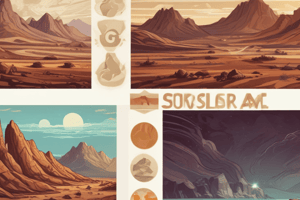Podcast
Questions and Answers
What is the thickness range of the Earth's crust?
What is the thickness range of the Earth's crust?
5-70 km
What are the two main divisions of the Earth's mantle?
What are the two main divisions of the Earth's mantle?
Upper and lower mantle
What is the process responsible for earthquakes, volcanic activity, mountain building, and sea-floor spreading?
What is the process responsible for earthquakes, volcanic activity, mountain building, and sea-floor spreading?
Plate movement
What is the region of the Earth where living organisms exist?
What is the region of the Earth where living organisms exist?
What are the two main types of weathering?
What are the two main types of weathering?
What is the process responsible for transporting weathered particles away from their source?
What is the process responsible for transporting weathered particles away from their source?
What is the layer of gases surrounding the Earth?
What is the layer of gases surrounding the Earth?
What is the solid, rocky part of the Earth?
What is the solid, rocky part of the Earth?
What is the term for the movement of tectonic plates?
What is the term for the movement of tectonic plates?
What is the term for the Earth's water, including oceans, lakes, rivers, and groundwater?
What is the term for the Earth's water, including oceans, lakes, rivers, and groundwater?
Flashcards are hidden until you start studying
Study Notes
Earth's Structure
- The Earth is composed of three main layers:
- Crust: outermost solid layer, ranging in thickness from 5-70 km
- Mantle: thick, viscous layer beneath the crust, divided into upper and lower mantle
- Core: innermost layer, composed of a solid inner core and a liquid outer core
Plate Tectonics
- The Earth's lithosphere (outer layer) is broken into several large plates that move relative to each other
- Plate movement is responsible for:
- Earthquakes
- Volcanic activity
- Mountain building
- Sea-floor spreading
Earth's Systems
- Hydrosphere: all the Earth's water, including oceans, lakes, rivers, and groundwater
- Atmosphere: the layer of gases surrounding the Earth
- Geosphere: the solid, rocky part of the Earth
- Biosphere: the region of the Earth where living organisms exist
Weathering and Erosion
- Weathering: the breakdown of rocks into smaller particles, through:
- Mechanical weathering (e.g. freeze-thaw cycles)
- Chemical weathering (e.g. oxidation, dissolution)
- Erosion: the transportation of weathered particles away from their source, through:
- Water (e.g. rivers, ocean currents)
- Wind
- Ice (e.g. glaciers)
Earth's Processes
- Rock Cycle: the continuous process of rock formation, transformation, and destruction
- Water Cycle: the movement of water between the Earth's systems, including:
- Evaporation
- Condensation
- Precipitation
- Runoff
Earth's Resources
- Renewable resources: resources that can be replenished naturally, such as:
- Solar energy
- Wind energy
- Water
- Non-renewable resources: resources that cannot be replenished naturally, such as:
- Fossil fuels (e.g. coal, oil, gas)
- Minerals (e.g. iron, copper)
Studying That Suits You
Use AI to generate personalized quizzes and flashcards to suit your learning preferences.




